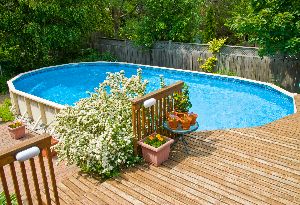
With the arrival of spring, you may be preparing to open your pool so that you can enjoy the warmer weather. However, after several months without using the feature, handle some pool care tasks will ensure the water is fresh and healthy for you to swim. Shocking the pool is one of the most significant aspects, and below is a brief overview about what this involves.
What Is Pool Shock?
Adding chlorine and other chemicals to a pool helps eliminate illness-causing bacteria so that the people swimming in the water stay healthy. The key to treating pool water is to balance the chemical levels. Otherwise, the chlorine can react with other materials and produce chloramines, which are chlorine and nitrogen molecules that can irritate eyes and skin. When the water has a strong chlorine smell, it means chloramines are present, not that the water is clean.
Shocking is the process of incorporating chlorine into the pool water to disinfect it thoroughly by raising the free chlorine (FC) level. This is the level required to remove contaminants from the water. It is called “shocking” the pool because you introduce a considerable amount of chlorine at once, helping eliminate algae and germs.

When Should You Apply Shock?
You don’t have to wait for a chlorine imbalance before handling this pool care task. Generally, you should shock the water once every two weeks to maintain balanced levels. However, the pool may need weekly treatment if you use it frequently or experience heavy rainfall. Wait until after the sun sets to apply the shock because the rays can destabilize the chlorine and cause it to burn, reducing the chemical’s effectiveness.
How Do You Apply It?
Begin the pool care process by testing the water’s pH, FC, and total chlorine (TC) levels. By subtracting the FC from the TC, you get the combined chlorine level, which helps you determine how much to add. Once you have these figures, prepare the shock according to its packaging instructions. Turn on the pool pump and dump the chemicals into the water along the pool’s edges. Run the pump for at least six hours, and test the water’s pH levels again. The pool is safe to use when the FC levels are between one and three parts per million.
When you need professional pool care services, turn to Don Marcum’s Pool Care in Cincinnati, OH. They have been helping residents since 1967, offering everything from pool accessory sales to cleaning services for hot tubs, spas, and in-ground pools. Visit them online to learn more about their services, and call (513) 561-7050 to speak to a team member about your needs.
About the Business
(144 reviews)
Have a question? Ask the experts!
Send your question

